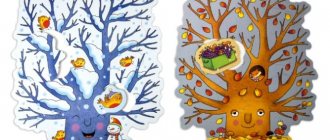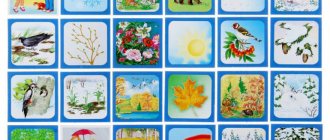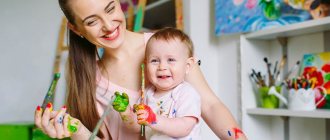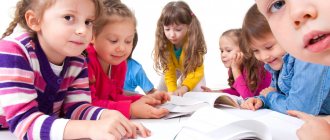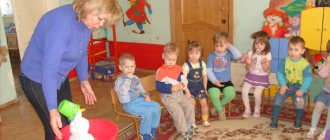Exploratory activities on a walk in different seasons
Experience 1:
make a cut with a shovel so that all layers of soil are visible.
♦ How many layers of soil does the ravine have? Which? (Below there are stones, then sand with clay and the top fertile layer of soil.)
Add water.
How does water penetrate soil layers? (The fertile layer of soil easily allows water to pass through; clay and sand do not, because there is no air in the clay.)
What vegetation predominates in the ravine? (Flowers and Curves.)
Experience 2:
consider the top fertile layer of soil.
♦ What is contained in this soil layer? (Rotten matter , their roots, animal remains.)
Guys, to prevent the ravines from getting bigger, people have found a way to strengthen the soil. To do this, you need to plant trees along the slope of the ravine. Their roots are long, penetrate far deep and help keep the soil from being washed away by rain streams. And the clay part of the soil is favorable for tree roots, as it retains moisture longer, and the tree can drink.
Examine through a magnifying glass the branch from which a leaf has just fallen.
♦What did we see? (Barely noticeable buds.)
What does it mean? (The trees did not die, they only shed dead, unnecessary leaves.)
The teacher invites the children to conduct an experiment.
Pour water into a glass jar, close the lid tightly and leave in the cold. Soon the can will split, and instead of it there will be a piece of ice. Frozen water - ice - takes up more space than liquid water, so the ice in the jar became crowded, and it broke it. Ice appears on puddles, rivers, and ponds as soon as the first frost hits. With each frosty day, the ice crust becomes thicker. What happens to ice if it is brought into a warm room? (It will melt.)
What kind of snow can you sculpt from? Try to make a ball of snow.
Compare the freezing time of clean and colored water in large and small molds.
Compare the rate of melting of snow packed tightly or loosely in a glass.
Examine the tracks of birds, compare them with the tracks of a crow. Answer, what is the difference between birds and animals?
Find clouds that look like horses. Compare cirrus and cumulus clouds.
Winter
Research activities
Measure the depth of snow with a snow gauge in different parts of the site.
Determine the condition of the soil in winter.
Catch a flying snowflake on a blank sheet of paper, examine it and determine the properties of snow (snowflake, dust, grain, flakes).
Examine the tracks of birds, compare them with the tracks of a crow. Answer, what is the difference between birds and animals?
Rays of light always travel in a straight line, and if
If any object comes across their path, it casts a dark shadow. Conduct observation - in the morning, at noon, in the evening. (At noon, the sun is directly overhead, the shadow is very short; early in the morning and in the evening the sun drops in the sky, the shadows become long.)
“Cognitive - research activities of preschoolers on walks”
Author information
Irgizzeva Olga Alekseevna –
Teacher of the preschool educational institution kindergarten “Kolosok”, Cherkasskoe village, Saratov region, Volsky district
2017
Cognitive and research activities of children on a walk
«
- A gram of your own experience is worth more than a ton of other people’s instructions.
Mahatma Gandhi
The main goal of educational and research activities
preschoolers on a walk is
development of creative, independent
personalities
Ensuring the psychological well-being of children's health
Development of creative imagination and thinking
Tasks
development
Development of communication skills
Development of cognitive abilities
- Relevance.
Every child strives for discovery from the first minute of life, and we, adults, need to help him in this by organizing support for research activities. The standard of the second generation in elementary school is also subject to this. Therefore, cognitive and research activities during a walk in kindergarten will become a very important step in preparing a child for school.
- According to the Federal State Educational Standard for Preschool Education. Cognitive and research activities are one of the priority types of children's activities in the educational field of “Cognitive Development”.
A large part of the walks is devoted to observations (pre-planned) of natural phenomena and social life. Observations can be carried out with a whole group of children, with subgroups, as well as with individual children. The teacher attracts some to observations in order to develop attention, while others arouse interest in nature or social phenomena, etc.
The surrounding life and nature provide an opportunity to organize interesting and varied observations. For example, you can pay attention to the clouds, their shape, color, and compare them with images known to children.
Excursions around the territory of the kindergarten and beyond, as well as along the ecological trail, are conducted with the aim of observing seasonal changes in nature, developing research activities to study objects of living and inanimate nature. Using observations of living nature objects, you can teach your child effective ways to interact with the environment. The excursion provides an opportunity to expand the scope of children’s experimental activities.
Children's experimentation is one of the methods of teaching and developing the natural science concepts of preschoolers. During research activities, a preschooler learns to observe, think, compare, answer questions, draw conclusions, establish a cause-and-effect relationship, and follow safety rules. The mastery of systematized search-cognitive knowledge of children, the formation of experimental actions forms the foundations of logical thinking, ensures maximum efficiency of the intellectual development of preschool children.
SUCCESS
OF COGNITIVE AND RESEARCH ACTIVITIES:
- Anyone can work with this technology, as it is interesting for both children and adults.
- A child is an explorer from birth, but consciously does something at the age of 5 (senior preschooler), and a child can be prepared for this activity from an early age. The ability for intellectual effort, research skills, logic and ingenuity will not become stronger on their own. Both parents and teachers can help here.
- It is important to have a laboratory atmosphere.
Form of work: classes with all children, with a subgroup, individually, etc.
IT IS NECESSARY TO TEACH CHILDREN THE FOLLOWING SKILLS:
- See problems;
- To ask questions;
- Make hypotheses;
- Define concepts;
- Classify;
- Observe;
- Ability to conduct experiments;
- Structure the material obtained during research;
- Draw conclusions and conclusions;
- Prove and defend your ideas.
There are many exercises for this:
1. SEE PROBLEMS.
A PROBLEM IS A DIFFICULTY, UNCERTAINTY THAT REQUIRES
SOME ACTION.
“Look at the world through someone else’s eyes” - if you look at the same object from different points of view, you will definitely see something new.
For example: we read the story: “In the morning the sky was covered with black clouds and it began to snow. Large snow flakes fell on houses, trees, sidewalks, lawns, roads....”
Assignment: continue the story, but you need to do this in several ways:
- You're just walking...
- You are a truck driver...
- You are a crow sitting on a tree...
- A bunny or a fox in the forest...
Game "Magic Transformations"
Based on this game, we conduct a thought experiment: What happens if water is heated?
What happens to the snow in the group? What happens if you set fire to paper? Etc .
2. MAKE HYPOTHESES AND ASSUMPTIONS.
1.You can specifically train with the help of an exercise
“Let's think together... How do birds find out the way home?
(Why do birds sing? Why do metal planes fly?) And here are some hypotheses: “birds determine the road by the sun and stars”, “birds are led by those who have already flown south”, “birds from above see trees, grass, flowers and they show them the way"
Thus, hypotheses, assumptions, and provocative ideas allow us to set up real and thought experiments. In order to learn how to develop hypotheses, you need to learn to think and ask questions.
To do this we use the words:
- May be….
- Let's assume...
- Let's say...
- Maybe …
- What if …
IMAGINE THAT...
- The weapon became the size of an eagle
- People have shrunk several times.
- Elephants have become smaller than cats.
WHAT WILL HAPPEN?
3.ASK QUESTIONS
4. Observe.
THE MOST POPULAR AND AVAILABLE RESEARCH METHOD. TO OBSERVE, IT IS IMPORTANT TO HAVE OBSERVATION – IT IS A ALLOY OF ATTENTION AND THINKING.
5.MAKING CONCLUSIONS AND CONCLUSIONS:
1. “How people look at the world”:
“Because different people look at the world differently.”
2. “Explain the meaning of the expression” (Simple, familiar proverbs and sayings - we discuss collectively)
3. Tell me what they look like:
- The outlines of the trees outside the window,
4. Search for objects that have common characteristics:
- Name objects that are both solid and transparent
- ... shiny, blue, hard.
Name as many living creatures as possible with the following characteristics: kind, noisy, active, strong.
WHAT DOES
PROVIDE COGNITIVELY :
- A child who feels like a researcher, who has mastered the art of experimentation, overcomes indecision and self-doubt.
- He awakens to initiative, the ability to cheerfully overcome difficulties, experience failures and achieve success, the ability to evaluate and admire the achievement of a comrade, and the willingness to come to his aid. In general, the experience of one’s own discoveries is one of the best schools of character.
It is very valuable that our children do not expect a momentary answer from us, but try to find the answer themselves, saying: “I think... I know... I saw...”, thus, they are able to reason, exchange opinions and knowledge.
WE ARE INTERESTED TO KNOW EVERYTHING
Performance:
Improving the quality of mental activity.
Increased level of perception.
Increasing interest in the content of the activity
.
Thank you for your attention.
Organization of surveillance
To organize observation, you need to properly prepare the process:
- Choose a plant or animal that looks healthy.
- The place must be clean and consistent with natural conditions.
- The chosen place should be well lit, it is better if the light falls slightly from the side.
- Children need to be positioned so that none of them interfere with each other or block the view.
- If possible, each child should touch a plant or pet an animal.
Convenient placement of children around the object being studied
Approximate plan for a walk-observation
The process of reviewing and discussing an object should comply with the following recommendations:
- Children need about 2 minutes to make their first impression. During this time, the children will have time to examine the object and satisfy their curiosity.
- The teacher should talk about the object in 1 minute.
- Next, children’s thoughts need to be directed in the right direction. If necessary, read a poem or ask a riddle. This is how the children form an emotional attitude towards the object. The time should not exceed 7 minutes.
- Afterwards, the object is examined in detail. The teacher asks leading questions and helps with answers. Provides missing information. This will take no more than 10 minutes.
- At the end, a summary is summed up and all the knowledge gained is connected with each other. This process takes about 5 minutes.
Additional Information! The teacher can start a colorful observation diary together with the children.
Children's research activities during a spring walk
Research activity involves the child’s independent search for information.
Organization
You can organize the process in the following ways:
- Children, while answering questions about the object in question, try to correctly express their own thoughts.
- When observing an object for a long time, the guys notice all the changes and, if necessary, record them.
- When observing living or inanimate nature, additional items are used: dark glasses, gardening tools.
- During an excursion, when they go to the city, to a library, a food factory, or when observing construction work, production technology or the process of organizing services is studied.
- After visiting the museum, a more detailed study occurs by looking at the encyclopedia or other materials.
You can also organize experiments under the close supervision of a teacher.
